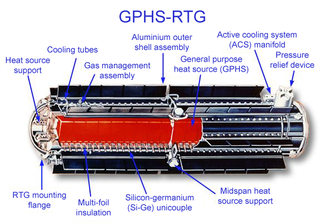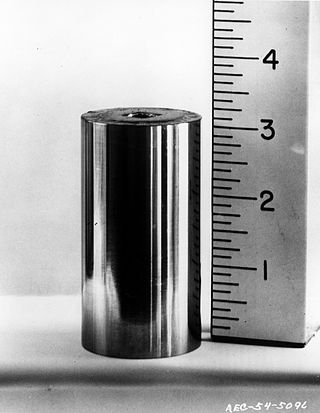
Strontium is a chemical element; it has symbol Sr and atomic number 38. An alkaline earth metal, strontium is a soft silver-white yellowish metallic element that is highly chemically reactive. The metal forms a dark oxide layer when it is exposed to air. Strontium has physical and chemical properties similar to those of its two vertical neighbors in the periodic table, calcium and barium. It occurs naturally mainly in the minerals celestine and strontianite, and is mostly mined from these.

Nuclear fallout is the residual radioactive material propelled into the upper atmosphere following a nuclear blast, so called because it "falls out" of the sky after the explosion and the shock wave has passed. It commonly refers to the radioactive dust and ash created when a nuclear weapon explodes. The amount and spread of fallout is a product of the size of the weapon and the altitude at which it is detonated. Fallout may get entrained with the products of a pyrocumulus cloud and fall as black rain. This radioactive dust, usually consisting of fission products mixed with bystanding atoms that are neutron-activated by exposure, is a form of radioactive contamination.
A dirty bomb or radiological dispersal device is a radiological weapon that combines radioactive material with conventional explosives. The purpose of the weapon is to contaminate the area around the dispersal agent/conventional explosion with radioactive material, serving primarily as an area denial device against civilians. It is not to be confused with a nuclear explosion, such as a fission bomb, which produces blast effects far in excess of what is achievable by the use of conventional explosives. Unlike the cloud of radiation from a typical fission bomb, a dirty bomb's radiation can be dispersed only within a few hundred meters or a few miles of the explosion.

The decay energy is the energy change of a nucleus having undergone a radioactive decay. Radioactive decay is the process in which an unstable atomic nucleus loses energy by emitting ionizing particles and radiation. This decay, or loss of energy, results in an atom of one type transforming to an atom of a different type.

A radioisotope thermoelectric generator, sometimes referred to as a radioisotope power system (RPS), is a type of nuclear battery that uses an array of thermocouples to convert the heat released by the decay of a suitable radioactive material into electricity by the Seebeck effect. This type of generator has no moving parts and is ideal for deployment in remote and harsh environments for extended periods with no risk of parts wearing out or malfunctioning.

A radioisotope heater unit (RHU) is a small device that provides heat through radioactive decay. They are similar to tiny radioisotope thermoelectric generators (RTG) and normally provide about one watt of heat each, derived from the decay of a few grams of plutonium-238—although other radioactive isotopes could be used. The heat produced by these RHUs is given off continuously for several decades and, theoretically, for up to a century or more.
An atomic battery, nuclear battery, radioisotope battery or radioisotope generator is a device which uses energy from the decay of a radioactive isotope to generate electricity. Like nuclear reactors, they generate electricity from nuclear energy, but differ in that they do not use a chain reaction. Although commonly called batteries, they are technically not electrochemical and cannot be charged or recharged. They are very costly, but have an extremely long life and high energy density, and so they are typically used as power sources for equipment that must operate unattended for long periods of time, such as spacecraft, pacemakers, underwater systems and automated scientific stations in remote parts of the world.

The Enguri Dam is a hydroelectric dam on the Enguri River in Tsalenjikha, Georgia. Currently, it is the world's second highest concrete arch dam, with a height of 271.5 metres (891 ft). It is located north of the town of Jvari. It is part of the Enguri hydroelectric power station (HES) which is partially located in Abkhazia.

Caesium-137, cesium-137 (US), or radiocaesium, is a radioactive isotope of caesium that is formed as one of the more common fission products by the nuclear fission of uranium-235 and other fissionable isotopes in nuclear reactors and nuclear weapons. Trace quantities also originate from spontaneous fission of uranium-238. It is among the most problematic of the short-to-medium-lifetime fission products. Caesium-137 has a relatively low boiling point of 671 °C (1,240 °F) and easily becomes volatile when released suddenly at high temperature, as in the case of the Chernobyl nuclear accident and with atomic explosions, and can travel very long distances in the air. After being deposited onto the soil as radioactive fallout, it moves and spreads easily in the environment because of the high water solubility of caesium's most common chemical compounds, which are salts. Caesium-137 was discovered by Glenn T. Seaborg and Margaret Melhase.
Various radionuclides emit beta particles, high-speed electrons or positrons, through radioactive decay of their atomic nucleus. These can be used in a range of different industrial, scientific, and medical applications. This article lists some common beta-emitting radionuclides of technological importance, and their properties.

This page discusses each of the main elements in the mixture of fission products produced by nuclear fission of the common nuclear fuels uranium and plutonium. The isotopes are listed by element, in order by atomic number.
The Systems Nuclear Auxiliary POWER (SNAP) program was a program of experimental radioisotope thermoelectric generators (RTGs) and space nuclear reactors flown during the 1960s by NASA.

Strontium-90 is a radioactive isotope of strontium produced by nuclear fission, with a half-life of 28.8 years. It undergoes β− decay into yttrium-90, with a decay energy of 0.546 MeV. Strontium-90 has applications in medicine and industry and is an isotope of concern in fallout from nuclear weapons, nuclear weapons testing, and nuclear accidents.

Since the mid-20th century, plutonium in the environment has been primarily produced by human activity. The first plants to produce plutonium for use in cold war atomic bombs were at the Hanford nuclear site, in Washington, and Mayak nuclear plant, in Chelyabinsk Oblast, Russia. Over a period of four decades, "both released more than 200 million curies of radioactive isotopes into the surrounding environment – twice the amount expelled in the Chernobyl disaster in each instance".

Nuclear power in space is the use of nuclear power in outer space, typically either small fission systems or radioactive decay for electricity or heat. Another use is for scientific observation, as in a Mössbauer spectrometer. The most common type is a radioisotope thermoelectric generator, which has been used on many space probes and on crewed lunar missions. Small fission reactors for Earth observation satellites, such as the TOPAZ nuclear reactor, have also been flown. A radioisotope heater unit is powered by radioactive decay and can keep components from becoming too cold to function, potentially over a span of decades.

Americium-241 is an isotope of americium. Like all isotopes of americium, it is radioactive, with a half-life of 432.2 years. 241
Am
is the most common isotope of americium as well as the most prevalent isotope of americium in nuclear waste. It is commonly found in ionization type smoke detectors and is a potential fuel for long-lifetime radioisotope thermoelectric generators (RTGs). Its common parent nuclides are β− from 241
Pu
, EC from 241
Cm
, and α from 245
Bk
. 241
Am
is not fissile, but is fissionable, and the critical mass of a bare sphere is 57.6–75.6 kilograms (127.0–166.7 lb) and a sphere diameter of 19–21 centimetres (7.5–8.3 in). Americium-241 has a specific activity of 3.43 Ci/g (126.91 GBq/g). It is commonly found in the form of americium-241 dioxide. This isotope also has one meta state, 241m
Am
, with an excitation energy of 2.2 MeV (0.35 pJ) and a half-life of 1.23 μs. The presence of americium-241 in plutonium is determined by the original concentration of plutonium-241 and the sample age. Because of the low penetration of alpha radiation, americium-241 only poses a health risk when ingested or inhaled. Older samples of plutonium containing 241
Pu
contain a buildup of 241
Am
. A chemical removal of americium-241 from reworked plutonium may be required in some cases.
The Lia radiological accident began on December 2, 2001, with the discovery of two orphan radiation sources near the Enguri Dam in Tsalenjikha District in the country of Georgia. Three villagers from Lia were unknowingly exposed. All three men were injured, one of whom eventually died. The accident was a result of unlabeled radioisotope thermoelectric generator (RTG) cores which had been improperly dismantled and left behind from the Soviet era. The International Atomic Energy Agency (IAEA) led recovery operations and organized medical care.













